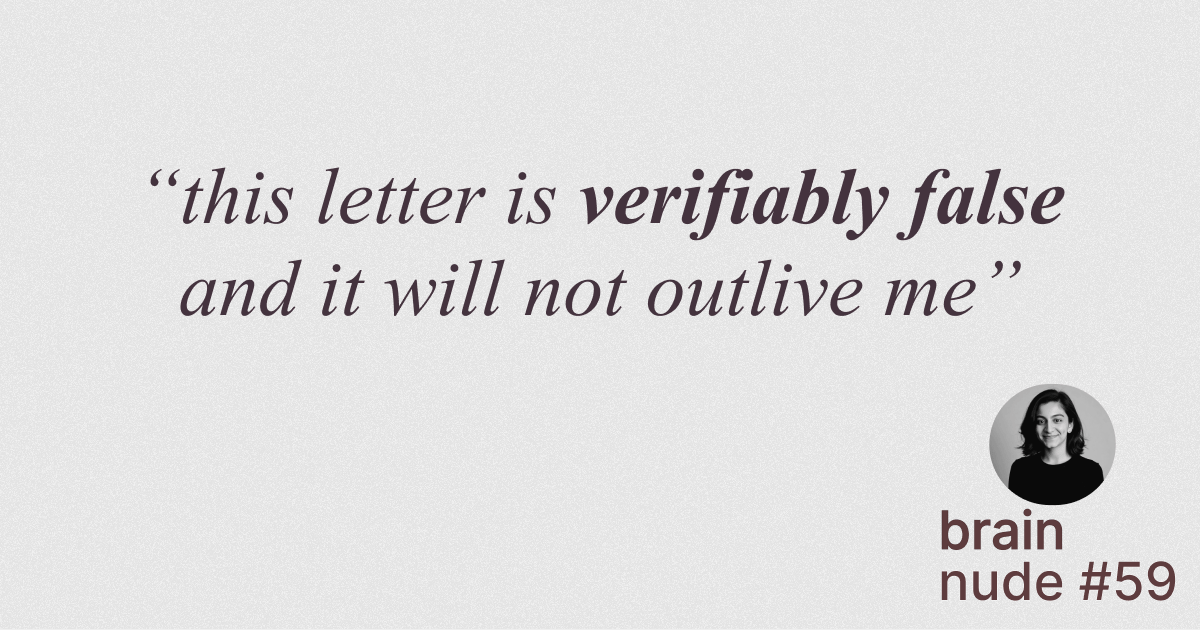- brain nudes
- Posts
- why a single codified judgment can become a career-ender (if you let it)
why a single codified judgment can become a career-ender (if you let it)

I was recently contacted by an investigative reporter working on a deeply researched feature about the collapse of my former employer (from 2018), a company now at the center of a $500M fraud investigation with RICO allegations.
I could tell immediately this wasn’t a rush job for clicks. It was rigorous, high-integrity journalism.
Dozens of interviews spanning years. Internal documents. Board communications. Staff correspondence. All cross-checked and corroborated to the highest degree.
At one point, they clarified:
“Every part of this story has to clear legal. Otherwise it doesn’t run.”
That’s the standard behind the kind of journalism that lands in The New York Times…not your typical TikTok hype cycle.
That convo hit me like a freight train.
Because for the first time, I saw with terrifying clarity what would’ve happened if a journalist of this caliber had come across the 2023 shutdown letter my investors sent me…and I hadn’t fought back…
Because here’s the truth:
Documents win.
Journalists don’t quote vibes — they quote paper trails.
Lawyers don’t ask what happened — they ask what was recorded.
And the internet doesn’t care about your comeback if your name is pinned next to the wrong PDF.
That 2023 investor letter — had I not challenged it — would’ve become the source material.
The thing future reporters, GCs, and risk committees quietly pull from the archive to decide if I’m safe to bet on.
The Document
In 2023, four institutional investors signed and emailed me a formal letter recommending the dissolution of my company.
They wrote that my “actions as CEO” had “irreparably reduced the company’s prospects for success.”
They cited “multiple actions taken in defiance of board decisions.”
This was not constructive feedback.
It was a final — and incorrect — judgment made 22 months into starting to build my company off a paper napkin idea.
Had I not pushed back daily, publicly, structurally, that letter would have become the anchor narrative about me:
In diligence rooms
In back channel reference calls
In hiring and compliance reviews
The sort of document that never needs to go viral to quietly close the next door.
Why This Should Matter To You:
We now operate in an AI-indexed world of real-time visibility and infinite traceability:
Capital moves faster.
Distribution is frictionless.
Records don’t disappear.
Every new “shot on goal” creates another exposure point.
One misstep — or one unchallenged document — can calcify into reputation.
Permanently.
That’s why I’m building SwayID:
A platform for founders, operators, and creators to capture good-faith intent, collect structured proof, and control their narrative trail in real-time — built specifically for the most ubiquitous and legally volatile format in advertising: UGC & influencer content.
In the class-action era a single untracked post or partner can become the freeze-frame that defines you — unless you own the record before someone else does.
When the FTC can fine $43,792 per non-compliant ad, and $150M+ lawsuits can surface years later, proof of compliance hygiene isn’t just protection.
It’s survival.
SwayID lets you keep velocity and verifiability — growth and defensibility.
What I Was Exposing Myself To (If I’d Stayed Silent):
Stage | Likely Reader Assumption | Consequence |
|---|---|---|
Source vetting | “Multiple VCs all agreed the founder was the problem.” | The default lens becomes: I blew it. |
Fact-checking | Allegations read as verified events. | I’d be stuck on my back foot having to retroactively narrate old events. |
Narrative construction | Early promise → leadership failure → investor consensus → collapse. | Any signs of growth could look like revisionist history. |
Quote selection | “Irreparably reduced.” “Defiance.” “Failure to provide a roadmap.” | The language could get republished uncontested. Forever. |
Framing | No rebuttal = tacit admission. | I could have become a cautionary tale instead of a founder forged through the fire. |
Why Letters Like This Stick Unless You Don’t Let Them:
Element | Why It’s Lethal |
|---|---|
Strong verbs (“defiance,” “failure”) | Create motive and blame in one stroke. |
Concrete gaps (“no roadmap”) | Hard to disprove retroactively. |
Absolute terms (“irreparably”) | Leave no room for interpretation. |
Institutional signatures | Turn speculation into perceived professional truth. |
If I hadn’t operated in good faith, documented every step, and owned my narrative from the moment I took my first investor check, here’s what all my earliest mistakes I made while learning to run my company could’ve cost me:
Future investors pass on taking meetings, with no explanation.
Future candidates opt out after a few reference checks.
Future partnerships disappear at the risk committee level.
The Only Reason That Didn’t (and Won’t) Happen to Me:
I responded directly, structurally, and in full view to show (not just tell) that this letter is verifiably false and it will not outlive me.
Published and timestamped my steps from Day 1.
Built a provable record of good-faith conduct over 3+ years.
Applied pressure until accountability was no longer optional.
The future belongs to anyone trying something new but only if they can move fast and prove good faith.
SwayID proudly exists to serve as infrastructure that prevents freeze-frame misjudgments, so your next opportunity isn’t thwarted by someone else’s incomplete snapshot.
-Kaeya